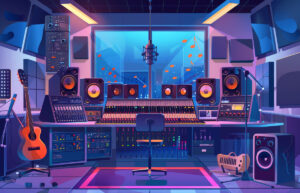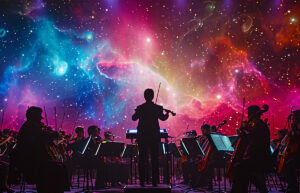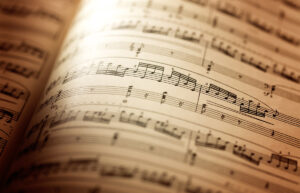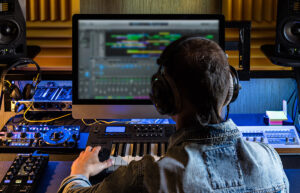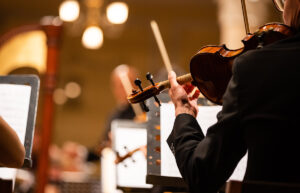What is Contemporary Music: Meaning, Evolution, Types, Characteristics & Future

Welcome to a world where melodies morph, rhythms redefine themselves, and musical expressions evolve at the speed of innovation. Contemporary music, a kaleidoscope of sonic adventures, paints a vibrant canvas where genres blend, styles collide, and artists rewrite the rules. Join us on a journey through this dynamic landscape as we unravel what is contemporary music and its intricacies, explore the influences, and invite you to be part of the ever-evolving symphony that is this genre.
Welcome to TheDemoStop, now join the community!
Connect with artists, fans and producers around the world.
What is contemporary music?
Contemporary music refers to the music being created and performed in the present era, reflecting today’s diverse influences, styles, and technological advancements. It encompasses various genres, from pop, rock, and hip-hop to electronic, experimental, classical, and beyond. To define what is contemporary music, the genre explores new sounds, unconventional techniques, and the fusion of various musical traditions, shaping the musical landscape of the modern age.
Evolution of contemporary music
Contemporary music, evolving since the mid-20th century, breaks from traditional norms. Influenced by avant-garde movements, technological advancements, and global cultural exchange, it spans diverse genres such as electronic, rock, hip-hop, and world music.
This era embraces experimentation, digital innovations, and a fusion of traditional and modern sounds, shaping a dynamic musical landscape and giving rise to what contemporary music is today.
Importance of contemporary music
Contemporary music holds immense importance in today’s cultural landscape as it reflects our societal, technological, and cultural evolution. It acts as a powerful mirror, capturing the diverse voices, experiences, and emotions of our times. Its significance lies in its ability to break traditional musical boundaries, embracing innovation, experimentation, and diversity.
Through its various genres, from electronic to hip-hop and beyond, contemporary music offers a platform for cultural representation and expression of the multifaceted identities and narratives of different communities. Moreover, it serves as a commentary on social issues, amplifying voices, raising awareness, and fostering dialogue about important societal matters.
Types of contemporary music
Jazz
Originating in the late 19th to early 20th century, jazz has evolved into a diverse genre characterized by improvisation, syncopation, and a blend of diverse musical traditions. It encompasses subgenres like traditional jazz, swing, bebop, fusion, and avant-garde, showcasing intricate melodies, complex harmonies, and innovative rhythmic patterns.
Hip-hop
Emerging in the Bronx in the 1970s, hip-hop has grown into a global cultural phenomenon encompassing rap music, DJing, breakdancing, and graffiti art. It is characterized by rhythmic rhyming lyrics delivered over beats, often addressing social issues, personal narratives, and cultural expressions, and has various subgenres like gangsta rap, conscious hip-hop, and trap.
Blues music
Originating in African-American communities in the late 19th century, blues music is characterized by its emotive lyrics, soulful melodies, and a 12-bar chord progression. It has influenced various genres, such as rock and roll, and its subgenres include Delta blues, Chicago blues, and electric blues.
Pop music
Popular music encompasses a broad range of styles designed for a wide audience. Catchy melodies, straightforward song structures, and accessibility characterize it. Pop music constantly evolves and incorporates elements from various genres, making it diverse and adaptable to contemporary trends.
R&B (Rhythm and Blues)
Originating in the 1940s, R&B combines elements of jazz, gospel, and blues. It is known for its soulful vocals, catchy rhythms, and emotional lyrics. Over time, R&B has evolved, incorporating electronic elements, funk influences, and diverse production techniques.
Characteristics of contemporary music
Complex time signatures
Contemporary music often features intricate and unconventional time signatures, departing from the standard 4/4 or 3/4 rhythms. This complexity adds depth and challenges traditional rhythmic expectations, allowing for more diverse and nuanced musical expressions.
Lack of defined structure
Unlike classical compositions with rigid structures, contemporary music often embraces a more fluid and experimental approach. It may lack clear verse-chorus structures, allowing for greater freedom in musical expression and storytelling.
Electronic & orchestral instruments
The use of electronic instruments alongside traditional orchestral instruments is a hallmark of contemporary music. This fusion enables artists to create innovative sounds, blending acoustic richness with the limitless possibilities offered by electronic music production.
Dissonant harmonies
Contemporary music frequently employs dissonance, using discordant tones or intervals to create tension and evoke emotions. This departure from traditional harmonic consonance adds depth and complexity to the musical experience.
Harmonic chord progressions
While dissonance is prevalent, contemporary music also explores harmonic chord progressions that deviate from conventional tonal systems. This exploration allows for unique and unpredictable harmonic sequences that challenge traditional notions of resolution and musical tension
Pitched percussion instruments
In contemporary music, pitched percussion instruments such as xylophones, marimbas, and vibraphones play a significant role. These instruments contribute melodic elements, adding texture and tonal diversity to compositions while blurring the lines between rhythm and melody.
Timbre and texture
Timbre, referring to the unique quality of a sound, and texture, relating to how sounds blend and interact, are crucial in contemporary music. Artists experiment with many sonic textures and timbres, mixing acoustic, electronic, and manipulated sounds to create depth and richness.
Welcome to TheDemoStop, now join the community!
Connect with artists, fans and producers around the world.
Contemporary music composers
John Williams
Renowned for his iconic film scores, John Williams is celebrated for composing some of the most recognizable cinematic music. His compositions for movies like “Star Wars,” “Indiana Jones,” “Jurassic Park,” and “Harry Potter” have left an indelible mark on contemporary music, blending orchestral richness with memorable melodies.
Phillip Glass
A prominent figure in minimalism, Phillip Glass is known for his repetitive structures and minimalist compositions that have influenced contemporary classical music. His works, such as “Einstein on the Beach” and “Koyaanisqatsi,” showcase intricate patterns and mesmerizing textures, shaping the landscape of modern classical music.
Ennio Morricone
Regarded as one of the greatest film composers, Morricone’s music spans various genres and emotions. His scores for movies like “The Good, the Bad, and the Ugly,” “Once Upon a Time in the West,” and “The Mission” are celebrated for their evocative themes, iconic melodies, and innovative use of instruments and arrangements.
Jennifer Higdon
A contemporary American composer, Jennifer Higdon’s compositions blend traditional and modern elements, earning her recognition with Pulitzer and Grammy awards. Her works, including orchestral pieces, chamber music, and concertos, exhibit lush harmonies, vivid orchestration, and emotional depth.
Unsuk Chin
A South Korean composer, Unsuk Chin‘s compositions are known for their inventive use of timbre, intricate textures, and avant-garde approaches. She explores electronic and orchestral realms, creating complex yet captivating musical landscapes that challenge traditional conventions.
The future of contemporary music
The future of contemporary music seems poised for a thrilling convergence of technological evolution, cultural diversity, and unbridled experimentation. Foremost, technology will continue to revolutionize the creation and dissemination of music, potentially ushering in AI-generated compositions, immersive virtual reality experiences, and interactive platforms that redefine artistic boundaries and deepen audience engagement.
Culturally, collaborations among artists from disparate backgrounds will likely intensify, fostering a rich tapestry of global influences and hybridized genres that transcend traditional boundaries. This blending of musical styles will push the envelope of sonic exploration, contributing to an even more diverse and eclectic musical landscape.
Conclusion
What is contemporary music?
Contemporary music refers to the music created and performed in the present time, encompassing diverse genres, styles, and innovative approaches that reflect current cultural, technological, and artistic influences.
Evolution of contemporary music
Contemporary music began to take shape in the mid-20th century, breaking away from conventional musical styles to embrace experimentation, technological progress, and cultural diversity.
Importance of contemporary music
Contemporary music is important as it reflects the present cultural, social, and technological landscape, serving as a platform for artistic innovation, cultural diversity, and societal expression.
Types of contemporary music
- Jazz
- Hip-hop
- Blues music
- Pop music
- R&B
Characteristics of contemporary music
- Complex time signatures
- Lack of defined structures
- Electronic & orchestral instruments
- Dissonant harmonies
- Harmonic chord progressions
- Pitched percussion instruments
- Timbre and texture
Contemporary music composers
- John Williams
- Phillip Glass
- Ennio Morricone
- Jennifer Higdon
- Unsuk Chin
The future of contemporary music
The future of contemporary music holds a dynamic blend of technological advancements, cross-cultural influences, and innovative audience experiences, shaping an ever-evolving and diverse musical landscape.
FAQs
What is contemporary music?
Contemporary music refers to present-day music reflecting current cultural influences, diverse genres, and modern artistic expressions.
How did contemporary music evolve?
Contemporary music began in the mid-20th century, diverging from traditional musical genres to explore experimentation, technological advancements, and cultural diversity.
Why is contemporary music important?
Contemporary music is vital as it reflects current cultural trends, fosters artistic innovation, and serves as a platform for diverse expressions in modern society.
What is the genre of contemporary music?
- Jazz
- Hip-hop
- Blues music
- Pop music
- R&B
What are the characteristics of contemporary music?
- Complex time signatures
- Lack of defined structures
- Electronic & orchestral instruments
- Dissonant harmonies
- Harmonic chord progressions
- Pitched percussion instruments
- Timbre and texture
Who are the composers of contemporary music?
- John Williams
- Phillip Glass
- Ennio Morricone
- Jennifer Higdon
- Unsuk Chin
What is the future of contemporary music?
The future of contemporary music entails continued technological integration, diverse cultural influences, genre-blending, and enhanced audience experiences, shaping an ever-evolving musical landscape.


